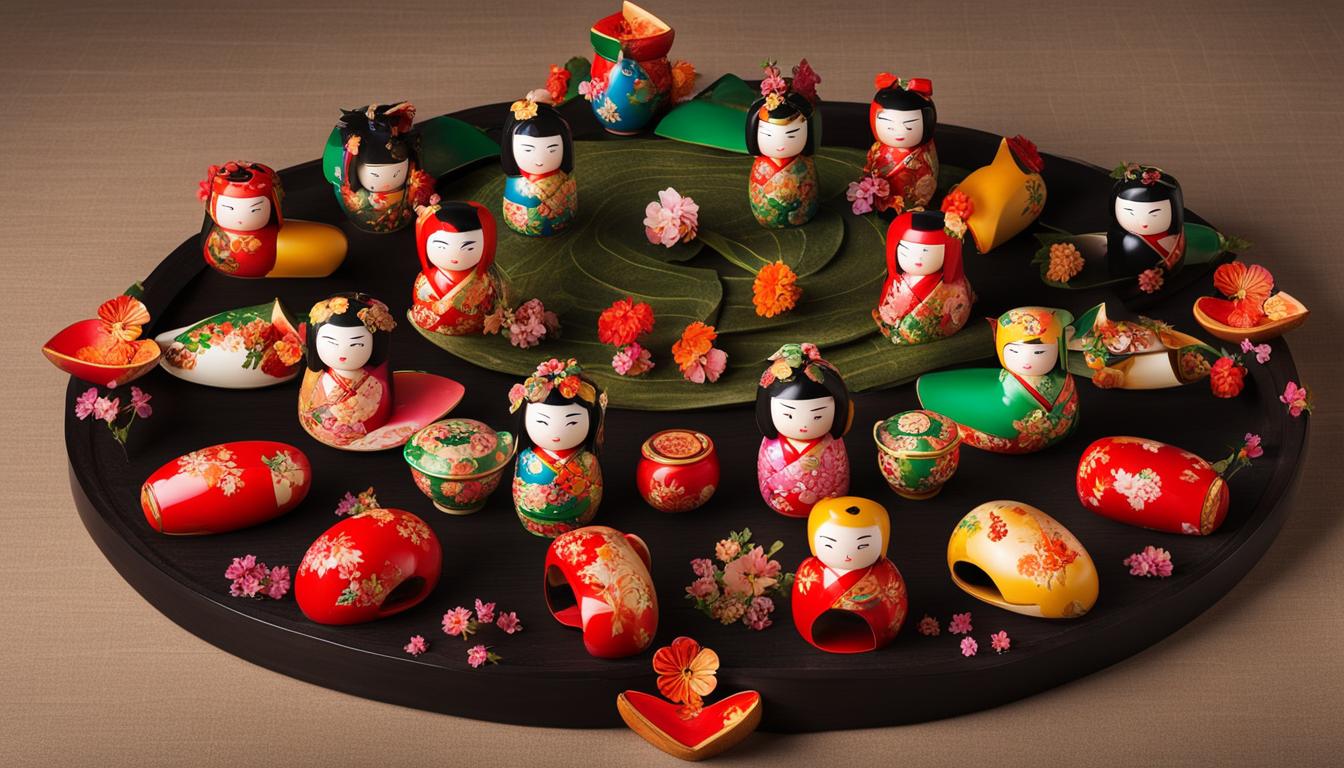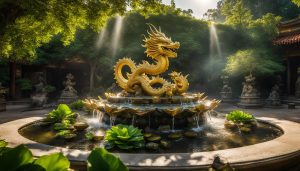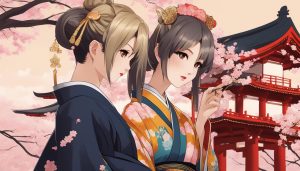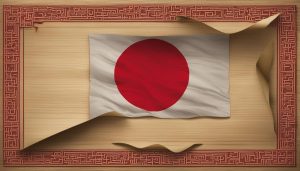Welcome to our article on the enchanting world of Japanese Kokeshi dolls! If you’ve ever wondered whether these traditional dolls bring good luck, you’re in the right place. Known for their unique design and cultural significance, Kokeshi dolls have long been considered a good luck charm in Japan. Let’s dive into the fascinating world of these dolls and explore the connection between luck, fortune, and the artistry behind these cherished creations.
Contents
Key Takeaways:
- Kokeshi dolls are believed to bring good luck to their owners.
- These traditional Japanese dolls have a unique design and are considered a good luck charm.
- Kokeshi dolls originated in Japan centuries ago and are crafted with great attention to detail.
- There are different styles of Kokeshi dolls, each with its own cultural symbolism.
- Kokeshi dolls have various uses, from children’s toys to collector’s pieces and works of art.
Origins and History of Kokeshi Dolls
Kokeshi dolls have a fascinating history that dates back centuries in Japan. These traditional Japanese dolls were originally crafted by wood craftsmen who repurposed leftover wood to make children’s toys. Over time, the dolls evolved into unique works of art that showcase the exquisite craftsmanship and cultural significance of Japan.
The distinct style of Kokeshi dolls features a long, elongated body and a round head, giving them a simplistic yet charming appearance. The craftsmanship involved in creating these dolls is considered a traditional Japanese art form, passed down through generations of skilled artisans. Each doll is meticulously hand-carved and painted, showcasing the dedication and talent of the craftsmen.
The origins of Kokeshi dolls are closely tied to the Tohoku region of Japan, particularly the hot springs areas. These dolls were initially sold as souvenirs to visitors of the hot springs, and their popularity quickly spread throughout the country. Today, Kokeshi dolls are celebrated as a symbol of Japanese craftsmanship and are cherished by collectors and enthusiasts around the world.
The Evolution of Kokeshi Dolls
Throughout history, Kokeshi dolls have undergone various transformations, reflecting the changing artistic styles and regional influences. Initially, the dolls had a simple design with minimal decoration. However, as the popularity of Kokeshi dolls grew, artists began incorporating intricate patterns and vibrant colors into their creations.
Each region in Japan developed its unique style of Kokeshi doll, often influenced by the local materials, cultural traditions, and artistic preferences. For example, the Naruko style from Miyagi Prefecture features beautifully painted floral patterns, while the Togatta style from Yamagata Prefecture has a more minimalist design with delicate lines and natural wood finishes.
Today, Kokeshi dolls continue to evolve as contemporary artisans experiment with new techniques and styles while staying true to the essence of this beloved Japanese craft. From traditional designs to modern interpretations, Kokeshi dolls are a testament to the artistic ingenuity and cultural heritage of Japan.
| Region | Style | Characteristics |
|---|---|---|
| Naruko | Colorful floral patterns | Elaborate hand-painted designs |
| Togatta | Minimalist | Delicate lines and natural wood finish |
| Yajiro | Serene facial expression | Simplicity and elegance |
| Sakunami | Graceful features | Smooth cylindrical shape |
| Tsuchiyu | Bold geometric patterns | Strong and vibrant colors |
Different Styles of Kokeshi Dolls
Kokeshi dolls are not only beautiful works of art but also reflect the rich cultural symbolism of Japanese culture. These dolls come in various styles, each originating from different regions of Japan and showcasing unique design characteristics and artistic techniques. Here are some of the popular styles of Kokeshi dolls:
Naruko Style
The Naruko style of Kokeshi dolls originated in the Naruko region of Miyagi Prefecture. These dolls are known for their vibrant colors and detailed hand-painted designs. The faces of Naruko dolls are often adorned with delicate patterns and feature intricate floral motifs.
Togatta Style
The Togatta style of Kokeshi dolls hails from the Togatta Onsen area in Miyagi Prefecture. These dolls are characterized by their slender and elongated bodies with a delicate, rounded head. Togatta dolls typically have simple yet elegant designs, with minimalistic painted patterns.
Sakunami Style
The Sakunami style of Kokeshi dolls originated in the Sakunami Onsen area of Miyagi Prefecture. These dolls have a unique shape, with a cylindrical body and a rounded head. The design of Sakunami dolls is often inspired by the natural beauty of the region, featuring intricate landscapes, cherry blossoms, and seasonal motifs.
Other Styles
In addition to the aforementioned styles, there are numerous other styles of Kokeshi dolls, each with its own distinct characteristics. Some of these styles include Yajiro, Tsugaru, Nanbu, and Yamagata. Each style reflects the artistic traditions and cultural heritage of its respective region, making Kokeshi dolls a fascinating representation of Japanese craftsmanship and cultural symbolism.
When collecting Kokeshi dolls, you can explore the different styles and discover the unique beauty of each region’s artistic expression. Whether you appreciate the intricate patterns of Naruko dolls or the simplicity of Togatta dolls, each style has its own charm and story to tell. These dolls serve as not only decorative pieces but also as a window into the cultural richness of Japan.
Uses of Kokeshi Dolls
Kokeshi dolls have long been cherished in Japanese culture for their various uses and symbolic meaning. These traditional Japanese dolls serve not only as charming children’s toys but also as powerful talismans of good luck and fortune. Additionally, they are highly regarded as works of art due to the craftsmanship and cultural significance associated with their creation.
One of the primary uses of Kokeshi dolls is as traditional children’s toys. These dolls, with their distinctive long bodies and round heads, have been cherished by Japanese children for generations. They provide not only a source of entertainment but also serve as a cultural emblem, preserving the rich heritage and artistic traditions of Japan.
Furthermore, Kokeshi dolls are seen as symbols of hope for bountiful harvests and prosperity. In Japanese culture, it is believed that displaying these dolls in homes and agricultural fields can bring good luck and ensure a fruitful season. Farmers often rely on the presence of Kokeshi dolls as a protective charm, invoking the blessings of the spirits and natural forces for a prosperous harvest.
In recent years, Kokeshi dolls have gained popularity beyond their traditional uses. They have become sought-after collector’s pieces for both art enthusiasts and those fascinated by Japanese culture. With their intricate designs and exquisite craftsmanship, Kokeshi dolls are highly valued as works of art. Collectors appreciate the attention to detail and the unique characteristics of each doll, as well as the historical and cultural significance they represent.
The Table: Different Styles of Kokeshi Dolls
| Style | Region |
|---|---|
| Naruko | Miyagi |
| Togatta | Miyagi |
| Yajiro | Niigata |
| Sakunami | Miyagi |
| Tsugaru | Aomori |
| Nakonosawa | Gunma |
| Tsuchiyu | Fukushima |
| Nanbu | Iwate |
| Zao Takayu | Miyagi |
| Hijori | Akita |
| Yamagata | Yamagata |
| Kijiyama | Niigata |
In conclusion, Kokeshi dolls hold a special place in Japanese culture and are cherished for their various uses and cultural symbolism. Whether as children’s toys, symbols of good luck and fortune, or esteemed works of art, these traditional Japanese dolls continue to captivate people around the world with their beauty and historical significance.
Where to Find Kokeshi Dolls
If you’re fascinated by the beauty and cultural significance of Kokeshi dolls, you’ll be delighted to know that Japan offers various places where you can find these traditional treasures. One popular destination for Kokeshi doll enthusiasts is the Miyagi Zao Kokeshi Museum, located in Japan. This museum is a haven for anyone interested in learning about the origins and craftsmanship of Kokeshi dolls.
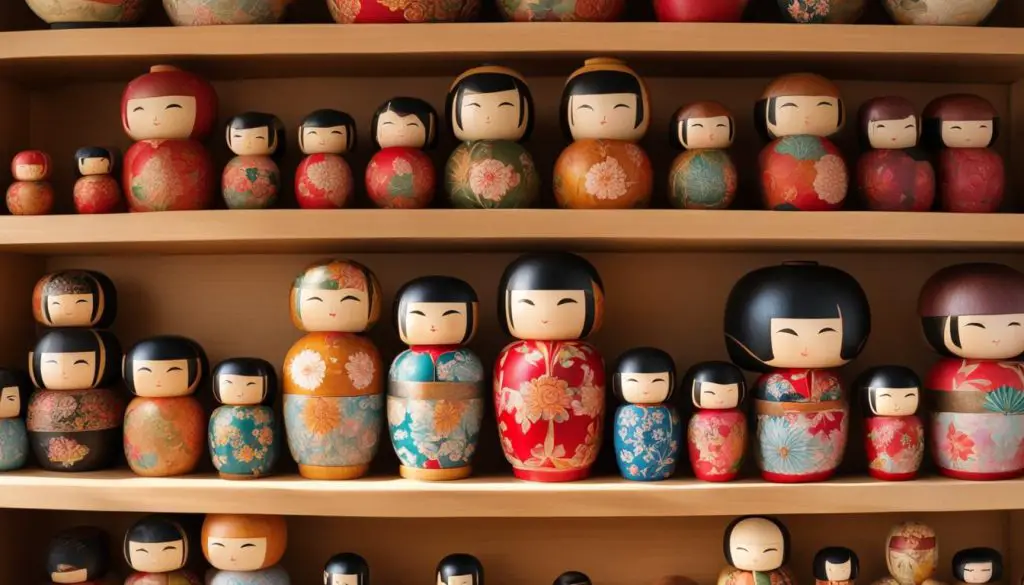
The Miyagi Zao Kokeshi Museum houses an impressive collection of over 5,500 Kokeshi dolls, each showcasing the unique style and craftsmanship of different Japanese regions. Visitors to the museum can explore the exhibits and gain a deep appreciation for the cultural symbolism and intricate designs of these dolls.
One highlight of visiting the Miyagi Zao Kokeshi Museum is the opportunity to paint your own Kokeshi doll. The museum offers workshops where you can unleash your creativity and design a personalized Kokeshi doll to take home as a special memento of your visit. This hands-on experience allows you to connect with the artistry and tradition behind these cherished dolls.
Aside from the Miyagi Zao Kokeshi Museum, you can also find Kokeshi dolls in local shops and markets throughout Japan. These shops specialize in traditional crafts and offer a wide selection of Kokeshi dolls. Exploring these local establishments can be a delightful adventure, allowing you to discover unique pieces and perhaps even meet local artisans who craft these dolls with love and skill.
Conclusion
Are you curious whether Japanese Kokeshi dolls bring you good luck? These traditional Japanese dolls carry more than just cultural symbolism. With their unique design and meticulous craftsmanship, Kokeshi dolls are believed to bring luck and fortune to their owners.
As traditional Japanese dolls, Kokeshi dolls have a long history and are considered works of art. They have been passed down through generations, showcasing the skill and expertise of Japanese craftsmen. Whether used as children’s toys or collector’s pieces, these dolls add a touch of tradition and luck to any space.
If you’re looking for a meaningful charm that encompasses the essence of Japanese culture, consider adding a Kokeshi doll to your collection. With their cultural symbolism, Japanese craftsmanship, and the belief in luck and fortune, these dolls truly hold a special place in the hearts of many.
FAQ
Do Kokeshi dolls bring good luck?
Yes, Kokeshi dolls are believed to bring good luck to their owners.
What are Kokeshi dolls?
Kokeshi dolls are traditional Japanese dolls with a unique design and cultural symbolism related to luck and fortune.
How did Kokeshi dolls originate?
Kokeshi dolls originated in Japan centuries ago when wood craftsmen started making children’s toys from leftover wood.
How many styles of Kokeshi dolls are there?
There are several styles of Kokeshi dolls, including Naruko, Togatta, Yajiro, Sakunami, Tsugaru, Nakonosawa, Tsuchiyu, Nanbu, Zao Takayu, Hijori, Yamagata, and Kijiyama.
What are the uses of Kokeshi dolls?
Kokeshi dolls are often used as children’s toys and are believed to bring good luck and fortune. They are also considered works of art and can be collected.
Where can I find Kokeshi dolls?
You can find Kokeshi dolls at the Miyagi Zao Kokeshi Museum in Japan, as well as in local shops and markets that specialize in traditional crafts.

